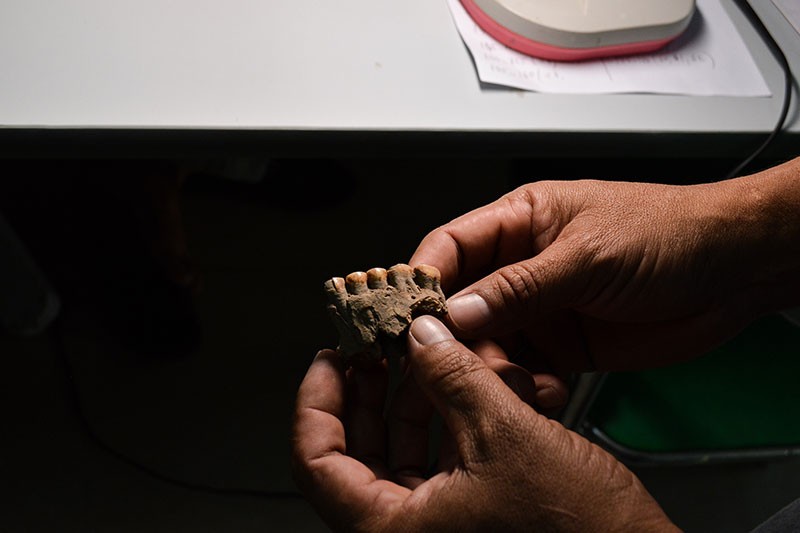A French-Cambodian archaeological team has unearthed tantalizing new artifacts from beneath a cave in Battambang province that may prove to be the earliest signs of human occupation and art in the region—and the first indication of cannibalism.
The artifacts were discovered beneath the floor of Battambang’s Laang Spean cave during a February dig by the French-Cambodian Prehistoric Mission, a collaboration between archaeologists from the Ministry of Culture and the National Museum of Natural History in Paris. The team has found 71,000 years worth of human remains during past visits to the site.

The latest discoveries include a palmsized stone tool buried deeper than any other artifact found at the site to date, a stone with what appears to be deep etchings, and fragments of what may be a shattered human skull found amid prehistoric food scraps.
Heng Sophady, an archaeologist and the deputy director of the Culture Ministry’s cultural heritage department, said the objects still needed to be dated and tested, but, if validated, they could change archaeologists’ understanding of Cambodia’s earliest residents.
Among the most intriguing finds are the skull fragments, although the team cannot rule out the possibility that they belonged to a large primate until it conducts radiocarbon dating in France, as well as possible DNA testing.
“If human, it’s really, really rare,” Mr. Sophady said. Though past excavations have unearthed Neolithic burial sites dating from 1,700 to 1,300 B.C., the skull fragments were found deeper beneath the cave floor, scattered amid prehistoric dinner scraps of the Hoabinhian people, hunter-gatherers who resided in the area between 9,000 and 3,000 B.C.
“Therefore, we thought maybe the people [were] eating people, and they threw the skull” with the other scraps, Mr. Sophady said.
“We did not see any other bones, just the skull,” he said, adding that there could be other bones scattered in a nearby plot that had yet to be unearthed.
The archaeologists also found a large stone featuring what appear to be etchings in the shape of an arrow, dyed with a redocher color, also at the Hoabinhian stratigraphic level.
“It could be the first case of art in Cambodia,” Mr. Sophady said.
Viewed headon, the stone’s two cavities suggest the face of an animal. “For me, I see a serpent,” Mr. Sophady said, adding that further testing in France would determine whether the etchings were manmade.
The stone was found in the second of three layers—indicating three distinct eras—below Laang Spean that the French-Cambodian team have identified since they began annual excavations at the cave site in 2009. The topmost, Neolithic layer was notable for its concentration of pottery shards and stone jewelry adorning five burial sites. The middle, Hoabinhian layer consisted mostly of stone tools, mollusc shells and the bones of rhinoceros, bats, monkeys and other animals. Beneath that, the team uncovered more rudimentary stone tools from as far back as 69,000 B.C.
One discovery made during the latest dig may push that date—which already makes Laang Spean one of the oldest sites in the region—back further still. A palm-sized tool, hewn from sandstone and quartz, was found at a deeper sediment layer than any prior discovery. Samples will eventually be sent to New Zealand for confirmation of the artifact’s age, according to Mr. Sophady.
The latest expedition to the cave marks the 50th anniversary of its discovery by a French couple in the 1960s. Roland and Cecile Mourer, now in their 70s, accompanied Hubert Forestier, a professor of prehistory at the Natural History museum in Paris and leader of the French archeologists, during the February dig—and are optimistic that more mysteries await.
“We think that there [are] still many discoveries that will be found in the cave,” Ms. Mourer said in an email.
And it’s likely that Laang Spean isn’t the only site still holding secrets. Mr. Sophady has found Hoabinhian stone tools in the fields surrounding the nearby Doun Mei hill, which houses unexplored caves of its own.
But that hill—the inspiration for a 1950s Cambodian pop song—is currently being quarried by a Chinese company looking for limestone, Mr. Sophady said.
“If they destroy the mountain, they will destroy the environment and also destroy the authenticity and history of the area,” he said.
Mr. Sophady said he had asked the provincial governor to keep the company from using dynamite on the hill until archeologists had an opportunity to inspect the area, but that he doubted the firm would take kindly to such a survey.
“They are afraid we will find something important,” he said. “And then we will waste their time, waste their money.”